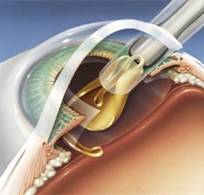Cataract Surgery Centre
Located in HKBH East Kowloon Medical Centre (EKMC), the Cataract Surgery Centre is comprised of a team of optometrists and professional medical nurses led by experienced Ophthalmologists, equipped with advanced ophthalmic equipment, it provides safe and reliable ophthalmology services, and high-quality Cataract Surgery service to the public.
What is Cataract?
The structure of human eye is similar to that of a camera. When light rays enter the eyes, they pass through the cornea and the lens. The cornea and lens focus an image automatically onto the retina, on which the optic nerve transmits the image to the brain.

Cataract means cloudiness of the lens. If the degree of cloudiness is getting more severe, it may obstruct the passage of light rays, vision will then become blurry. Hyper mature cataract may result in glaucoma and uveitis, or even blindness.
How is Cataract formed?
Cataract is mainly caused by natural aging process. Other causes include inheritance, trauma, diabetes mellitus and certain kinds of medication consumption.
Symptoms of Cataract
- Blurring
- Hypersensitivity to strong light
- Dimmer color sensation
- Poor light sensation when reading
- Frequent change of refractive error
How to cure Cataract?
The most effective way to cure cataract is surgery. Thanks to the modern medical technologies, removal of cataract and implantation of intraocular lens (IOL) can be performed safely and effectively under surgical microscope. Cataract surgery is regarded as one of the most successful surgical procedures. More than 95% of cataract patients have their vision improved after the surgery.
With the latest technology, Phacoemulsification, and the use of foldable IOL, the size of the surgical wound has been largely reduced. During the surgery, a small ultrasound probe is inserted into the eye through a very small wound. The ultrasound emitted from the probe will break down the cataract into small pieces, which are then absorbed by one of the orifices on the probe. Finally, the IOL is implanted.

Current Choices of Intraocular Lens
The modern intraocular lens (IOL) is not only focusing light but also filtering away damaging light from the eye.
Traditional IOL can only filter ultraviolet light. Blue filtering IOL can filter high frequency blue light, which possesses higher energy, as well as ultraviolet light. This new filtering function, works like the natural lens, may further reduce the chance of retina damage from blue light.
 Traditional IOL
Traditional IOL  Blue Filtering IOL
Blue Filtering IOL
Intraocular Lens with Specific Refractive Functions
The latest IOL allows some patients to achieve spectacle independence after operation. For example toric IOL allows correction of astigmatism together with myopia or hypermetropia in the same setting. Multifocal IOL improves near, intermediate, as well as distant vision in some presbyopic patients. You may discuss with your eye doctor the available options to suit your needs in daily living.
| Near Vision | Intermediate Vision | Distance Vision | Astigmatic Correction | |
| Monofocal IOL |
✓ (One of the distances) |
|||
| Astigmatism-correcting (toric) monofocal IOL |
✓ (One of the distances) |
✓
|
||
| Mutifocal IOL | ✓ | ✓ | ✓ | |
| Astigmatism-correcting (toric) multifocal IOL | ✓ | ✓ | ✓ | ✓ |
* Effective from 25 March 2025 (Tuesday), Refractive Cataract Surgery Centre will be relocated to HKBH East Kowloon Medical Centre (EKMC), the first and brand new medical centre under Hong Kong Baptist Hospital in Kwun Tong Business Area (Ngau Tau Kok). We look forward to serving you at the new location.
Service Hours (By appointment only)
| Monday to Friday | 9:00am – 12:30pm; 2:00pm – 5:00pm |
| Saturday | 9:00am – 2:00pm |
| Sunday and Public Holidays | Closed |
For enquiries and appointments, please contact us at:


Cataract Surgery Package
Phacoemulsification + intraocular implantation (ONE eye only) Packages
* Additional charge will be levied for toric and multifocal lens other than monofocal IOL.
| Services | Package (Out-patient) |
| Resident Doctor’s professional fee and local anaesthesia fee | √ |
| Ultrasound ( A-Scan) | √ |
| Operation Theatre and procedure fee | √ |
| Monofocal IOL | √ |
| Nursing care and treatment (Ward) | Not applicable |
| Bed charge (one night in General Ward) | Not applicable |
| Basic pharmacy and materials associated with the procedure | √ |
| 3 follow up consultations (the first consultation on the post operation day is included) | √ |
For enquiries and appointment to pre-operative eye screening, please call Cataract Surgery Centre – HKBH East Kowloon Medical Centre:


